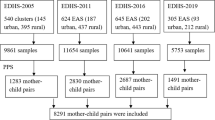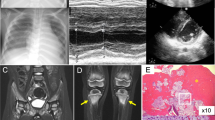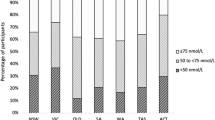Abstract
Objective: This study was designed to estimate the prevalence of and evaluate risk factors for subclinical vitamin A deficiency in Arab-Bedouin children at age 18 months, followed from birth.
Design: Community-based, prospective, cohort study conducted in Rahat, a large Arab-Bedouin township, located near the city of Beer Sheva in the Negev region of southern Israel.
Subjects: Healthy Bedouin infants (n=117) from the township, born at Soroka University Medical Center (SUMC) in Beer Sheva, were randomly recruited at birth. Enrollment was restricted to well infants born weighing >2500 g at birth.
Results: More than 15% of the children had serum retinol concentrations below 0.7 μmol/l. Male sex (odds ratio (OR) 4.17 [1.14–15.32], P=0.031), stunting at age 12 months (OR 10.09 [2.00–50.97], P=0.05) and warm season at age 18 months (OR 6.20 [1.36–28.28], P=0.018) were associated with vitamin A deficiency. Maternal education decreased the risk of vitamin A deficiency (OR 0.81 [0.68–0.95], P=0.011).
Conclusions: Study results indicate a significant vitamin A deficiency problem among Bedouin children. Deficiency may be prevented by increasing dietary intake of vitamin A, especially during the warm season. Other interventions include preventing and controlling diarrheal diseases in order to avert nutritional stunting, and providing nutritional education to women of childbearing age.
Sponsorship: This study received financial support from the National Institute of Allergy and Infectious Diseases (AI-26497), the US–Israel Bi-national Science Foundation (BSF 90-00257), and the National Academy of Sciences/Institute of Medicine (AID/ANE 0158-G-SS-9035-00).
This is a preview of subscription content, access via your institution
Access options
Subscribe to this journal
Receive 12 print issues and online access
$259.00 per year
only $21.58 per issue
Buy this article
- Purchase on SpringerLink
- Instant access to full article PDF
Prices may be subject to local taxes which are calculated during checkout
Similar content being viewed by others
References
Ahmed FU, Rahman ME & Mahmood CB (2000): Vitamin A deficiency in children with acute diarrhoea: a community-based study in Bangladesh. J. Health Popul. Nutr. 18, 119–122.
Asrat YT, Omwega AM & Muita JW (2002): Prevalence of vitamin A deficiency among pre-school and school-aged children in Arssi Zone, Ethiopia. East Afr. Med. J. 79, 355–359.
Congdon NG & West Jr KP (2002): Physiologic indicators of vitamin A status. J. Nutr. 132, 2889S–2894S.
D’Souza RM & D’Souza R (2002): Vitamin A for the treatment of children with measles—a systematic review. J. Trop. Pediatr. 48, 323–327.
Dibley MJ, Staehling N, Nieburg P & Trowbridge FL (1987): Interpretation of Z-score anthropometric indicators derived from the international growth reference. Am. J. Clin. Nutr. 46, 749–762.
El-On J, Dagan R, Fraser D & Deckelbaum RJ (1994): Detection of Cryptosporidium and Giardia intestinalis in Bedouin children from southern Israel. Int. J. Parasitol. 24, 409–411.
Faber M & Spinnler Benade AJ (2000): Factors associated with low serum retinol levels in children aged 6–24 months in a rural South African community. Public Health Nutr. 3, 395–402.
Feungpean B, Suthutvoravut U, Supapanna S, Rakthai S & Chatvuttinun S (2002): Vitamin A status in premature infants. J. Med. Assoc. Thai. 85 (Suppl. 4), S1219–S1223.
Finkelman Y, Yagupsky P, Fraser D & Dagan R (1994): Epidemiology of Shigella infections in two ethnic groups in a geographic region in southern Israel. Eur. J. Clin. Microbiol. Infect. Dis. 13, 367–373.
Forman MR, Guptill KS, Chang DN, Sarov B, Berendes HW, Naggan L & Hundt GL (1990): Undernutrition among Bedouin Arab infants: the Bedouin Infant Feeding Study. Am. J. Clin. Nutr. 51, 343–349.
Fraser D, Bilenko N, Deckelbaum RJ, Dagan R, El-On J & Naggan L (2000): Giardia lamblia carriage in Israeli Bedouin infants: risk factors and consequences. Clin. Infect. Dis. 30, 419–424.
Fraser D, Dagan R, Naggan L, Greene V, El-On J, Abu-Rbiah Y & Deckelbaum RJ (1997): Natural history of Giardia lamblia and Cryptosporidium infections in a cohort of Israeli Bedouin infants: a study of a population in transition. Am. J. Trop. Med. Hyg. 57, 544–549.
Galloway P, McMillan DC & Sattar N (2000): Effect of the inflammatory response on trace element and vitamin status. Ann. Clin. Biochem. 37, 289–297.
Gorodischer R, Sarov B, Gazala E, Hershkovitz E, Edwardson S, Sklan D & Katz M (1995): Differences in cord serum retinol concentrations by ethnic origin in the Negev (southern Israel). Early Hum. Dev. 42, 123–130.
Grotto I, Mimouni M, Gdalevich M & Mimouni D (2003): Vitamin A supplementation and childhood morbidity from diarrhea and respiratory infections: a meta-analysis. J. Pediatr. 142, 297–304.
Khandait DW, Vasudeo ND, Zodpey SP & Kumbhalkar DT (2000): Risk factors for subclinical vitamin A deficiency in children under the age of 6 years. J. Trop. Pediatr. 46, 239–241.
Levy A, Fraser D, Vardi H & Dagan R (1998): Hospitalizations for infectious diseases in Jewish and Bedouin children in southern Israel. Eur. J. Epidemiol. 14, 179–186.
McLaren DS & Frigg M (2001): Sight and life manual on vitamin A deficiency disorders (VADD), pp 1–163. Basel, Switzerland: Task Force SIGHT AND LIFE.
Miller M, Humphrey J, Johnson E, Marinda E, Brookmeyer R & Katz J (2002): Why do children become vitamin A deficient? J. Nutr. 132, 2867S–2880S.
Mills JL, Tuomilehto J, Yu KF, Colman N, Blaner WS, Koskela P, Rundle WE, Forman M, Toivanen L & Rhoads GG (1992): Maternal vitamin levels during pregnancies producing infants with neural tube defects. J. Pediatr. 120, 863–871.
Oso OO, Abiodun PO, Omotade OO & Oyewole D (2003): Vitamin A status and nutritional intake of carotenoids of preschool children in Ijaye Orile community in Nigeria. J. Trop. Pediatr. 49, 42–47.
Porat N, Levy A, Fraser D, Deckelbaum RJ & Dagan R (1998): Prevalence of intestinal infections caused by diarrheagenic Escherichia coli in Bedouin infants and young children in Southern Israel. Pediatr. Infect. Dis. J. 17, 482–488.
Ramakrishnan U (2002): Prevalence of micronutrient malnutrition worldwide. Nutr. Rev. 60, S46–S52.
Ramakrishnan U & Darnton-Hill I (2002): Assessment and control of vitamin A deficiency disorders. J. Nutr. 132, 2947S–2953S.
Redlich CA, Grauer JN, Van Bennekum AM, Clever SL, Ponn RB & Blaner WS (1996): Characterization of carotenoid, vitamin A, and alpha-tocopheral levels in human lung tissue and pulmonary macrophages. Am. J. Respir. Crit. Care Med. 154, 1436–1443.
Reyes H, Villalpando S, Perez-Cuevas R, Rodriguez L, Perez-Cuevas M, Montalvo I & Guiscafre H (2002): Frequency and determinants of vitamin A deficiency in children under 5 years of age with pneumonia. Arch. Med. Res. 33, 180–185.
Solon FS, Popkin BM, Fernandez TL & Latham MC (1978): Vitamin A deficiency in the Philippines: a study of xerophthalmia in Cebu. Am. J. Clin. Nutr. 31, 360–368.
Sommer A & Davidson FR (2002): Assessment and control of vitamin A deficiency: the Annecy Accords. J. Nutr. 132, 2845S–2850S.
Sommer A, Tarwotjo I & Katz J (1987): Increased risk of xerophthalmia following diarrhea and respiratory disease. Am. J. Clin. Nutr. 45, 977–980.
Sommer A (1996): In Vitamin A Deficiency: Health, Survival, and Vision. eds KP West Jr, JA Olson, AC Ross, pp xiii–438. New York: Oxford University Press.
Stephenson LS, Latham MC & Ottesen EA (2000): Global malnutrition. Parasitology 121 (Suppl), S5-22.
West Jr KP (2002): Extent of vitamin A deficiency among preschool children and women of reproductive age. J. Nutr. 132, 2857S–2866S.
World Health Organization (1995): Physical Status: the Use and Interpretation of Anthropometry. Report of a WHO Expert Committee. WHO Technical Report Series No. 854 Geneva: World Health Organization.
Author information
Authors and Affiliations
Contributions
Guarantor: D Fraser.
Contributors: CLC analysed data and wrote the initial and final manuscripts. AL was the study coordinator and contributed to the design, collection of data and editing of manuscripts. RG contributed to the interpretation of the nutritional analyses and to editing the manuscripts. RD supervised the microbiological aspects of the study and contributed to the microbiological analysis of the stool specimens, and editing the manuscripts. RJD and DF wrote the grant proposal and edited manuscripts. WSB supervised the laboratory processing and analyses of the blood specimens. DF contributed to the design, analysis and editing of the final manuscripts.
Corresponding author
Rights and permissions
About this article
Cite this article
Coles, C., Levy, A., Gorodischer, R. et al. Subclinical vitamin A deficiency in Israeli-Bedouin toddlers. Eur J Clin Nutr 58, 796–802 (2004). https://doi.org/10.1038/sj.ejcn.1601879
Received:
Revised:
Accepted:
Published:
Issue date:
DOI: https://doi.org/10.1038/sj.ejcn.1601879
Keywords
This article is cited by
-
Risk factors for vitamin A and D deficiencies among children under-five in the state of Palestine
Conflict and Health (2018)
-
Vitamin-A deficiency and its determinants among preschool children: a community based cross-sectional study in Ethiopia
BMC Research Notes (2016)
-
What is Known About Health and Morbidity in the Pediatric Population of Muslim Bedouins in Southern Israel: A Descriptive Review of the Literature from the Past Two Decades
Journal of Immigrant and Minority Health (2015)



